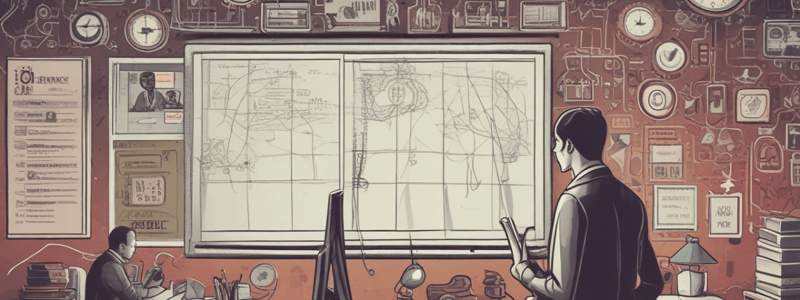Podcast
Questions and Answers
What is the primary concern of an open system in an enterprise?
What is the primary concern of an open system in an enterprise?
- To create a strong culture
- To transform inputs into outputs (correct)
- To promote uncontrollable informal relations
- To maintain only formal relations
What is the primary effect of social facilitation on an individual's behavior?
What is the primary effect of social facilitation on an individual's behavior?
- It decreases performance due to distractions
- It has a negative effect on learned tasks
- It has no impact on performance
- It increases performance due to arousal (correct)
According to the Contingency School, what determines the structure and methods of operation of an organization?
According to the Contingency School, what determines the structure and methods of operation of an organization?
- The circumstances in which the organization exists (correct)
- The type of industry
- The personality of the leader
- The size of the organization
What type of task is characterized by the group's performance being equal to the sum of the performances of each group member?
What type of task is characterized by the group's performance being equal to the sum of the performances of each group member?
What is a common characteristic of a strong organizational culture?
What is a common characteristic of a strong organizational culture?
What is the primary effect of social inhibition on an individual's behavior?
What is the primary effect of social inhibition on an individual's behavior?
What is the primary function of organizational culture, according to Eldridge and Crombie?
What is the primary function of organizational culture, according to Eldridge and Crombie?
What is the primary reason for the decrease in performance in a group task?
What is the primary reason for the decrease in performance in a group task?
What is the primary effect of adding a group member to a small, cohesive group?
What is the primary effect of adding a group member to a small, cohesive group?
Which of the following is NOT a characteristic of an open system?
Which of the following is NOT a characteristic of an open system?
Who are the authors of the definition 'Organizational culture offers a shared system of meanings that is the basis for communications and mutual understanding'?
Who are the authors of the definition 'Organizational culture offers a shared system of meanings that is the basis for communications and mutual understanding'?
What is the primary effect of comparison on an individual's performance?
What is the primary effect of comparison on an individual's performance?
What is the main difference between the Contingency School and the traditional view of organizational design?
What is the main difference between the Contingency School and the traditional view of organizational design?
What type of task is characterized by the group's performance being based on the most talented group member?
What type of task is characterized by the group's performance being based on the most talented group member?
What is the primary effect of evaluation apprehension on an individual's performance?
What is the primary effect of evaluation apprehension on an individual's performance?
What is the result of an organization's attempt to minimize the opportunity for uncontrollable informal relations?
What is the result of an organization's attempt to minimize the opportunity for uncontrollable informal relations?
What are norms in an organizational culture?
What are norms in an organizational culture?
What happens when norms are violated in an organization?
What happens when norms are violated in an organization?
What is the primary purpose of norms in an organization?
What is the primary purpose of norms in an organization?
In what way can artefacts contribute to an organization's culture?
In what way can artefacts contribute to an organization's culture?
What is the relationship between an organization's values and its culture?
What is the relationship between an organization's values and its culture?
What happens when an organization's values are strongly held?
What happens when an organization's values are strongly held?
What is the primary way in which norms are passed on in an organization?
What is the primary way in which norms are passed on in an organization?
What is the significance of a traumatic event in an organization's culture?
What is the significance of a traumatic event in an organization's culture?
What type of interdependence occurs when the completion of a task by one person affects the completion of a task by another person?
What type of interdependence occurs when the completion of a task by one person affects the completion of a task by another person?
What is the conflict style of a person who reacts to conflict by pretending that it does not exist?
What is the conflict style of a person who reacts to conflict by pretending that it does not exist?
What is the approach to handling conflict in which one of the parties removes themselves from the situation to avoid the conflict?
What is the approach to handling conflict in which one of the parties removes themselves from the situation to avoid the conflict?
What is the conflict style of a person who tends to respond to conflict by giving in to the other person?
What is the conflict style of a person who tends to respond to conflict by giving in to the other person?
What is the approach to handling conflict in which an individual allows each side to get some of what it wants?
What is the approach to handling conflict in which an individual allows each side to get some of what it wants?
What is the conflict style of a person who responds to conflict by always trying to win?
What is the conflict style of a person who responds to conflict by always trying to win?
What is the name of the model that predicts behaviors based on four key personality traits?
What is the name of the model that predicts behaviors based on four key personality traits?
What is the conflict style of a person who wants a conflict resolved in such a way that both sides get what they want?
What is the conflict style of a person who wants a conflict resolved in such a way that both sides get what they want?
What is the purpose of a gatekeeper in an organization?
What is the purpose of a gatekeeper in an organization?
What determines the order of communication in a queue?
What determines the order of communication in a queue?
What is the distance range of the personal distance zone?
What is the distance range of the personal distance zone?
What is the purpose of escape in an organization?
What is the purpose of escape in an organization?
What is an example of multiple channel in an organization?
What is an example of multiple channel in an organization?
What is the distance range of the social distance zone?
What is the distance range of the social distance zone?
What involves the way we say things and consists of variables such as tone, tempo, and volume?
What involves the way we say things and consists of variables such as tone, tempo, and volume?
What is the distance range of the public distance zone?
What is the distance range of the public distance zone?
Study Notes
Organizational Culture
- Minimizes opportunity for informal relations, leaving room only for formal ones.
- Transforms inputs into outputs within its environment.
- The Contingency School (Burns and Stalker, 1961; Woodward, 1965; Lawrence and Lorsch, 1969) analyzed various organizations and concluded that their structures and methods of operation are a function of the circumstances in which they exist.
Definitions of Organizational Culture
- A strong culture is a system of informal rules that spells out how people are to behave most of the time (Deal and Kennedy, 2000).
- The culture of an organization refers to the unique configuration of norms, values, beliefs, and ways of behaving that characterize the manner in which groups and individuals combine to get things done (Eldridge and Crombie, 1974).
Components of Culture
- Values: Beliefs in what is best or good for the organization and what should or ought to happen.
- Norms: Unwritten rules of behavior, the "rules of the game" that provide informal guidelines on how to behave.
- Artefacts: Visible and tangible aspects of an organization that people hear, see, or feel and contribute to their understanding of the organization's culture.
Social Facilitation and Inhibition
- Social Facilitation: Positive effects of the presence of others on an individual's behavior.
- Social Inhibition: Negative effects of others' presence.
Group Performance
- Additive Tasks: Group performance is equal to the sum of the performances by each group member.
- Conjunctive Tasks: Group performance depends on the least effective group member.
- Disjunctive Tasks: Group performance is based on the most talented group member.
Conflict Styles
- Avoiding Style: Reacting to conflict by pretending it does not exist.
- Withdrawal: Removing oneself from the situation to avoid the conflict.
- Triangling: Discussing a conflict with a third-party to resolve the issue without direct confrontation.
- Accommodating Style: Responding to conflict by giving in to the other person.
- Forcing Style: Responding to conflict by always trying to win.
- Collaborating Style: Resolving conflicts in a way that both sides get what they want.
- Winning at All Cost: Seeking to win regardless of the damage to the other side.
Communication
- Nonverbal Cues: Paralanguage, personal distance zones, and social distance zones.
- Message Interpretation: Message can change depending on the way the receiver interprets the message.
- Gatekeeper: A person who screens potential communication for someone else and allows only the most important information to pass through.
Studying That Suits You
Use AI to generate personalized quizzes and flashcards to suit your learning preferences.
Description
Understand the concept of an organization in industrial psychology, including its characteristics and definitions.




